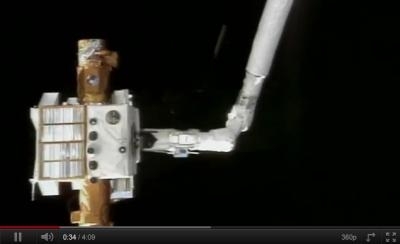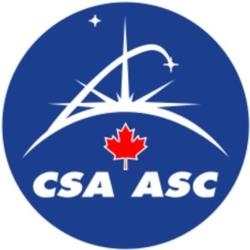Wed, Nov 09, 2011
Canadian Space Agency Salutes Three Decades Of Industry
Innovation
Canadarm, which many consider to be Canada's national icon of
technological innovation, made its space debut on the U.S. Space
Shuttle on November 13, 1981. Designed to deploy and retrieve space
payloads, the robotic arm quickly became a critical element in the
Space Shuttle Program. It worked flawlessly for 90 Shuttle
missions, spending a total of 944 days in space and travelling the
equivalent of over 387 million miles.

"It took incredible vision—and courage—to suggest an
element that would be both visible and critical to the Shuttle
program," said Steve MacLean, President of the Canadian Space
Agency (CSA). "The foresight of those early pioneers ended up
spawning decades of experience in on-orbit servicing for our
industry. The Canadarm became an enduring symbol of Canadian
ingenuity, and branded our country as a world leader in space-age
technology."
The CSA is working to ensure that the Canadarm, even on Earth,
continues to inspire future generations of Canadians. "We are
bringing Canadarm back to Canada," stated Steve MacLean. "Since it
was designed to work in the weightlessness of space and not on
Earth, the arm has to be modified for public display before it can
be installed at the CSA Headquarters. We will later evaluate
whether this national icon can be shared with Canadians in other
locations," explains MacLean.

Some of the Canadarm's most famous achievements include
retrieving the Hubble Space Telescope for repair, connecting the
two first modules of the International Space Station (ISS) and
inspecting the Shuttle's heat shield to ensure its safe return to
Earth. The design and construction of the Canadarm marked the
beginning of Canada's close collaboration with NASA in human space
flight, leading to the creation of Canada's corps of
astronauts.
While the Canadarm was retired after the Space Shuttle's final
flight in July 2011, the arm's legacy lives on through the suite of
Canadian robots on board the ISS, as well as the innovations in
robotic prototyping being done under the Next-Generation Canadarm
Program. The Canadarm has also inspired several generations of
scientists and engineers to develop new technologies for industry,
medicine, and other applications, such as neuroArm (an
ultra-precise robot for neurosurgery) and KidsArm for pediatric
surgery.
More News
Aero Linx: International Federation of Airworthiness (IFA) We aim to be the most internationally respected independent authority on the subject of Airworthiness. IFA uniquely combi>[...]
Ultrahigh Frequency (UHF) The frequency band between 300 and 3,000 MHz. The bank of radio frequencies used for military air/ground voice communications. In some instances this may >[...]
A Few Questions AND Answers To Help You Get MORE Out of ANN! 1) I forgot my password. How do I find it? 1) Easy... click here and give us your e-mail address--we'll send it to you >[...]
From 2019 (YouTube Edition): Learning To Paint Without Getting Any On Your Hands PPG's Aerospace Coatings Academy is a tool designed to teach everything one needs to know about all>[...]
Also: Sustainable Aircraft Test Put Aside, More Falcon 9 Ops, Wyoming ANG Rescue, Oreo Cookie Into Orbit Joby Aviation has reason to celebrate, recently completing its first full t>[...]
 ANN's Daily Aero-Linx (05.06.25)
ANN's Daily Aero-Linx (05.06.25) ANN's Daily Aero-Term (05.06.25): Ultrahigh Frequency (UHF)
ANN's Daily Aero-Term (05.06.25): Ultrahigh Frequency (UHF) ANN FAQ: Q&A 101
ANN FAQ: Q&A 101 Classic Aero-TV: Virtual Reality Painting--PPG Leverages Technology for Training
Classic Aero-TV: Virtual Reality Painting--PPG Leverages Technology for Training Airborne 05.02.25: Joby Crewed Milestone, Diamond Club, Canadian Pilot Insurance
Airborne 05.02.25: Joby Crewed Milestone, Diamond Club, Canadian Pilot Insurance




